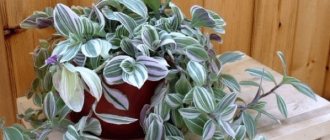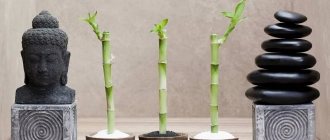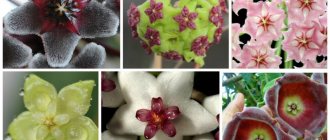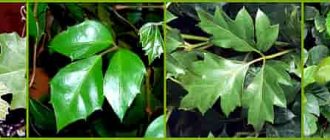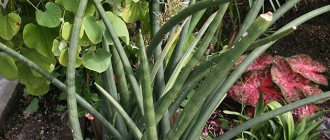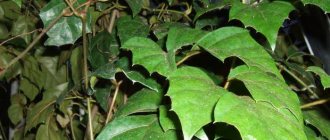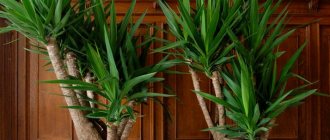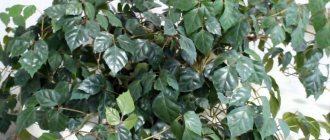Features of Pilea
Pilea is a hardy plant, reaching a height of 0.4 m and having decorative foliage. This plant is most often grown in winter gardens, warm flower beds and display cases. Pilea Cadieu differs from other species in its very rapid growth, which is of particular value for gardeners who use it when arranging compositions of various flowers. Small unisexual flowers are most often collected in axillary racemes. The plant distributes its fruits in an extremely unusual way, which is similar in its mechanism to ejection. By the time of fruiting, the sterile stamens (staminodes) grow greatly and only slightly support the fruit hanging over them. In a ripe fruit, the connection with the plant is greatly weakened. At this time, the sterile stamens straighten and throw the fruit up to a distance of one hundred meters.
Planting, replanting, pruning, propagation
Pilea is transplanted every year, as it is constantly growing and requires a larger container. This plant has very fine, delicate roots that are easily damaged, and they spread more widely than deep. Therefore, the pot should be shallow (seven to eight centimeters) and wide, with drainage holes at the bottom. Any material is suitable - both plastic and ceramics.
To grow Pilea, take soil with good breathability, light and not very dense - the looser the soil, the better. The easiest way is to buy ready-made soil mixture. You can make a mix at home by mixing equal parts of coarse sand, peat, turf and humus. Before use, this mixture must be calcined (in the oven or stove) or frozen.
Fine drainage (about 2 cm thick) is placed at the bottom of the pot, and a few centimeters of soil are placed on top of it. Then they carefully dig up the ground around the plant and transfer the roots into a new container, so as not to injure them. The rest of the soil is poured around the root system, forming an even layer.
It is strictly forbidden to plant the plant to a great depth, pressing it firmly to the bottom, or compact the soil - it should not be dense.
Since the pilea is characterized by rapid growth, pruning must be done frequently, otherwise the crown will look unaesthetic, and the foliage will fall off from the shoots that stretch to a great length. To make the plant lush, you can pinch the tops of the branches. If you cut it more radically, cuttings will remain - it is better to save them and use them for propagation.
Pilea can be propagated in two ways:
- Cuttings - segments of upper shoots with two or three leaf nodes are suitable for this. The length of the cuttings is about ten centimeters. They can be placed in a jar of water, or planted several at a time in sand or in small pots with soil. New seedlings quickly take root, after which they can be grown like ordinary pilea bushes, after keeping them in moderate coolness for a couple of weeks.
- Growing seeds, which is not suitable for all varieties. Seeds are purchased in a store and planted on a thin (no more than a centimeter) soil layer, and covered with glass or wrapped in plastic film on top. Watering should be moderate to simply moisten the soil. Within a month, the seeds should sprout, then the covering material is removed and the young plants are transplanted into separate containers.
The simplest is propagation using the first method - if only because you can take shoots cut from the bush as cuttings, and this will not require additional cash costs.
Caring for Pilea at home. Briefly
| Temperature | In summer 19-23 degrees, in winter 15-17, but not lower than 10 degrees. |
| Air humidity | High. |
| Lighting | Pilea at home needs bright, diffused light; east or west window. |
| Watering | Moderate; in summer 2-3 times a week, in winter 1 time a week. |
| Priming | Medium fertile with a neutral or slightly acidic reaction, permeable to water. |
| Feeding and fertilizer | During the growing season, apply liquid complex fertilizer once every 2 weeks. |
| Transfer | Once a year, in spring in wide pots. |
| Reproduction | Stem cuttings. |
| Features of cultivation | Does not tolerate drafts well and needs pruning and pinching. |
Popular varieties
This crop is not loved for its abundant flowering, although buds appear very rarely at home. This usually happens in the summer season. The flowers are small, white, monochromatic, collected in dense inflorescences. Against the background of bright foliage they are almost invisible.
The following varieties are in greatest demand among gardeners:
Pilea Cadiera
The height of the stems can reach 40 cm. Over time, they begin to branch. The leaves are oval-shaped with a pointed tip and three veins. Other popular names for the species are silver pilea, aluminum plant, which were given to it due to its striking colors. The bright green (or bluish-green) surface of the foliage is covered with two wide, intermittent stripes of a silvery hue.
Pilea adpressed
The leaves are light green, small, numerous. The bushes are squat and curly.
Pilea Alumi
The foliage is colored richly green, has a wrinkled, terry surface with veins of a crimson hue.
Other popular varieties of Pilea include:
- coin-leaved;
- thick-leaved;
- wrapped;
- peperomyoid;
- Lebanese;
- small-leaved;
- creeping.
Cadieux is one of the most common types of Pilea, famous for its variegated leaf color. The plant is unpretentious, so even a beginner can cope with its maintenance. Knowing what Pilea Cadieu is - home care, cultivation, propagation - will help you successfully cope with the task.
Source
Signs and superstitions
Do you believe in signs and superstitions associated with this flower?
I believe I don't believe
Pilea has a positive effect on the atmosphere in the home. When around her, people's anxiety decreases and their mood improves. Suitable for those who practice: in her presence it is easier to enter a meditative state.
It is a talisman for those born under the sign of Pisces. It is believed that Pilea Peperomiiformes has special energy and attracts money into the house, which is why it is also called the Chinese money tree.
According to floral feng shui, you should not keep fading plants at home - they take away vital energy. Give flower pots a place away from the bed and sofa. It is better not to place plants in the bedroom at all. But an excellent solution would be to fill empty niches and corners with them.
Expert opinion
Mokhov Andrey Petrovich
Graduated from KubSAU, specialty: agronomy
Pilea is not suitable for growing as a bonsai, but feels great in open and closed florariums.
Superstitions and signs about indoor flowers
It is believed that a house where indoor plants die is filled with negative energy. This is wrong. Most plants, when you take good care of them and devote a considerable part of your time, are able to ward off diseases and negative programs from their owners. When one plant withers, it means that it has warded off a strong evil eye, damage or serious illness. But this does not mean that there is negative energy in the house. Thank the dead flower, and then bury it on the street or in the area.
House flowers dry up one after another - either there is a presence of strong negativity in the house, or serious damage. But when it's not about care. Some plants are whimsical, and some of them react to loud sounds. A good explanation for the sign that says: flowers do not take root in a house where scandals are a frequent occurrence.
Flowers get sick and wither for natural reasons. This portends purchases.
With their help, the negative zones of the apartment are determined. When a plant that was growing well before the “move” begins to fade, for example, near the bed, then move the latter to another place.
When a plant blooms in the middle of winter and is covered with inflorescences in the summer, it’s a surprise. In certain regions of Russia and other countries - to death in the house. The interpretation also depends on the properties of the plant. Unexpected flowering of the money tree means the unexpected appearance of money.
It is believed that it is impossible to give plants in pots; this transfers the failures and problems of the giver to the person for whom the gift is intended. When you receive one, give a coin of any denomination in return. So the plant will think that it was bought and has received a new owner, and it does not need the energy of the old one.
Conditions of detention
Light
Pilea prefers soft, diffused light or partial shade. The best places to keep the culture are window sills in the west and east. It is acceptable to place a flower pot near a window on the south side.
In cloudy weather and periods of short daylight hours, you can use special devices. For example, phytolamps are perfect.
Temperature
Despite its southern origin, the culture does not like heat. The best temperature regime will be moderate. During the warm period, it is advisable to maintain 19-23 degrees above zero. In winter, it is worth placing the plant in a cool place (at 14-18 degrees). The only exception is the wrapped pilea. This variety becomes cold already at 18 C.
It is also important to exclude drafts and strong temperature changes. This applies to all types.
Pests, diseases, control measures
Both harmful insects and diseases attack the pilea when it is weakened - this happens due to non-compliance with the conditions of maintenance. To prevent the plant from getting sick, you need to properly care for it and regularly inspect the leaves for parasites.
| Pests and diseases | Causes | Symptoms | Treatment | Preventive measures |
| Rotting of the stem and root system. | Excessive soil moisture against a background of too low air temperature, which leads to infection of the roots and stem by fungus. | A drooping, flabby plant with crumbling foliage. The stem near the roots is abnormally soft, swollen, and the root system is rotting. | Transplantation into new soil and parallel treatment with Topaz. | Observe temperature standards and the optimal watering schedule for the plant. |
| Spider mite. | The most suitable conditions for insect damage to Pilea are heat, dry soil and insufficient air humidity. | Withering, flabby and crumbling leaves, dotted with dots (traces of tick bites through which it drinks the plant juice). You can see cobwebs on the underside of the foliage and on the stems. | The use of medications such as Fufanon, Decis or Aktara. | Maintain normal temperature and humidity. As an additional way to combat mites, spraying the pilea with water is suitable, after which you need to shake off the moisture from the leaves and let them dry. |
| Mealybug | The plant weakens, stops growing, shoots and foliage become covered with a sticky whitish substance. | Use the drug Aktara. | ||
| Thrips | Spots of dead tissue on the leaves, curled, dried shoots, and in severe cases a light coating covering the foliage. All these signs indicate the presence of thrips larvae, drawing juices from the leaves. | Treatment with Fitoverm at a concentration of 2 ml per 200 milligrams of water. After the procedure, wrap it in a plastic bag and leave it for a day. Another option is to use Actellik (1 ampoule is diluted in a liter of water, and the room is ventilated - the drug has a specific smell). | Treat with celandine tincture, remove the top layer of soil and replace it with fresh one, set sticky traps for insects. | |
| Shchitovka | Dried, curled, deformed leaves covered with brownish-orange tubercles (scale insect shells). | Two (seven days apart) treatment sessions with medicinal agents, such as Fitoverm or Actellik. | Wipe the leaves with a cloth soaked in soapy water to remove the shells, and check the plant again after six to seven days. |
What kind of soil is needed?
Land for Pilea can be purchased in specialized stores or prepared yourself. The composition is not complicated: humus, leaf soil, peat and sand in a ratio of 2:2:1:1.
Expert opinion
Mokhov Andrey Petrovich
Graduated from KubSAU, specialty: agronomy
If you make the mixture yourself, do not forget about disinfection. To do this, the soil needs to be calcined or frozen. It is also recommended to soak it in a solution of potassium permanganate to protect it from pests.
In the store, choose a mixture for decorative foliage flowers with an acidity pH of 5.5–6. A couple of hours before use, stir the soil to saturate it with oxygen. The purchased option is often the best, because maintaining proportions is not everything. It is difficult to find high-quality soil without impurities and diseases.
Even peat taken from the shore of a reservoir may not be suitable for indoor plants. Therefore, the ready-made mixture has more advantages than it seems. The only drawback is the price, but the result is worth it.
Do not forget about drainage, because the roots of the pilea do not tolerate stagnant moisture. You can use crushed bricks, pebbles, gravel, ceramic shards or expanded clay. When choosing a pot, choose a shallow, spacious option: the flower quickly grows in width, and the root system is superficial.
Reproduction
It is convenient to propagate Cadieu sawweed from cuttings left after routine pruning of the bush. 2 weeks after immersing the cuttings in a container of water, root shoots form at the base of the stems. These shoots can be planted next to the main bush, gradually rejuvenating it.
Propagation by cuttings is the fastest way to get another specimen
When propagating from seeds, planting material is planted in the ground, sprinkled, sprayed with a spray bottle and covered with glass (you can wrap the container with cling film). After germination, the glass or film is removed. After the formation of 2-3 leaves, they are planted. When it reaches 10 cm, it can be transplanted into a permanent pot.
Note! Propagation by seeds is a labor-intensive, time-consuming and ineffective method. It is rarely used.
An adult plant with a good root system can be propagated by dividing the bush.
Pilea propagation
When propagated at home, Pilea is propagated by cuttings.
The procedure can be carried out throughout the year, but the optimal time is spring: the pilea takes root faster and grows with young shoots.
Cuttings 7-10 cm long with 2-3 pairs of leaves are suitable for propagation. They should be planted in sand or adult plant substrate and covered with polyethylene or glass. The “greenhouse” is placed in a warm place, protected from direct sunlight, regularly ventilated and watered. When the cuttings have taken root and new leaves have appeared, the polyethylene or glass is removed.
Freshly cut cuttings can be placed in water, and when they have roots, they can be planted in individual pots. You can plant 2-3 cuttings in one container - such a bush will be more lush.
Description of the flower
Perennial evergreen shrub plant 30-40 cm high. The most common species of the genus Pileum (Pileum) of the Nettle family. The stems are thin, flexible, and strongly branched at the base. Young stems are erect. With age, they bend, fall off, and lose foliage near the base.
The leaves are oblong, long (10 cm long, 4 cm wide) with a pointed tip and base. Attached to the stem by short petioles. The surface of the leaves is glossy, uneven and bumpy. On the sides of the main vein there are two convex wide interrupted stripes of silver color. Two more stripes with the same inclusions run along the edges of the leaf plate. Against the background of lush green leaves, this pattern looks very impressive. The upper young leaves are lighter in color compared to the lower ones.
Pilea Cadieu has a dwarf small-leaved hybrid of a compact form up to 10 cm high.
In nature, Pilea Cadieu is found in the tropics of Indochina, growing in shaded areas, in the lower tier of tropical forests, protected from the sun.
For your information! Indoors, Pilea Cadieu produces volatile biologically active phytoncides that suppress the proliferation of staphylococcus bacteria. It can reduce the number of these harmful bacteria by 50-70%.
Transplantation
It is recommended to replant the Pilea annually. The most recommended time of year for this is spring. The choice of pot depends on the combined shape and size of all the roots. So, the container for the pilea should be spacious, but not very deep.
The plant will take root especially well in soil containing humus. To ensure that the liquid in the roots does not stagnate, it is necessary to ensure high-quality drainage of the liquid.
Light and soil
Plants of the genus Pilea generally prefer bright, but diffused sunlight without direct rays; some species easily tolerate partial shade. The most optimal place in the house is western or eastern windows. In summer, when shaded from the sun's rays, you can take the plant out into the open air.
Pilea requires minimal care at home, but it is important to provide it with proper lighting and good soil. With a lack of light, the leaves of the plant lose their decorative effect, especially in variegated forms.
Pileas are perfect for city apartments, where the temperature remains virtually unchanged throughout the year. The most optimal indicator for plants is a constant level of +25 °C. Although some species feel normal even at +10 °C (Pilea peperomyoid). The soil for the plant is recommended to be loose, well permeable to moisture, with a drainage layer. Use fertile loam with an equal share of good leaf humus.
Diseases and pests
Pilea is a fairly hardy plant. However, if the basic rules of caring for it are not followed, difficulties may arise. Here are the main problems and the reasons for their occurrence:
- The lower leaves of the Pilea fall off - incorrect watering regime (excess or lack of moisture).
- Pilea leaves turn black - the temperature is too low.
- Pilea leaves droop - insufficient watering.
- Pilea shoots are stretched - lack of sunlight.
- Drying spots appear on the leaves - these are burns due to direct rays of the sun hitting the plant.
- The lower parts of the branches become bare - the bush is degenerating and needs rejuvenation.
Among the pests, Pilea can be affected by aphids, scale insects, spider mites, and thrips.
Difficulties in growing
When growing Cadieu Pilea at home, you may encounter difficulties such as:
- Wrinkling and falling of leaves . This phenomenon indicates that the ambient temperature is too high or too low.
- Softening, blackening and falling of leaves , rotting of the base of the stems is evidence of excessive watering.
- Pale and lethargic leaves are caused by too much light.
- Fading of the silver stripe on the leaves , shallowing of the leaves and stretching of the shoots - this indicates a lack of lighting.
In addition to errors in care, an aluminum plant can be susceptible to attacks by harmful insects such as spider mites, thrips, scale insects and mealybugs.
In these cases, the main difficulty is that the onset of the lesion is difficult to immediately see, so the pilea must be regularly inspected and, if pests are detected, rescuing the plant must be started immediately. Did you know? Pilea can improve mood, relieve fatigue and reduce anxiety.
Carefully wash the silver pilea under hot shower jets, dry it and treat it with insecticides - preparations for killing pests of indoor plants, for example, "Aktara", "Aktellik", "Bona Forte bioinsecticide". Use of drugs is according to the instructions. Caring for the silver pilea is completely simple and accessible even to novice gardeners. Following simple rules for caring for a plant guarantees its amazing beauty.
Types of Pilea domestica with photos and names
Pilea peperomioides
Forms a compact bush, up to 45 cm high. On a rigid stem, rounded leaves on long petioles are placed oppositely. The leaf blade, up to 7 cm in diameter, is smooth, green in color, and slightly bent inward.
Cadie's Pilea, Silver Pilea (Pilea cadierei)
A bushy plant, up to 40 cm high. Young stems are erect, mature stems lean towards the soil and branch strongly. The leaves have an elongated oval shape, up to 5 cm wide, up to 20 cm long. The green leaf plate with three veins has two silvery lines along it. Small flowers are collected in axillary inflorescences.
Pilea microphylla
Perennial herbaceous plant, up to 15 cm high. Arched light green shoots are highly branched. They have many miniature light green leaves, up to 0.5 cm long, placed opposite them. The leaf blade is glossy, oval or round in shape. In the axils of the leaves, tiny flowers, both unisexual and bisexual, are collected in corymbose inflorescences.
Pilea filamentous (Pilea numiralifolia)
An ampelous plant with thin reddish shoots. Small rounded leaves, up to 1 cm long, are alternately placed on them. The underside of the leaf plate is painted purple.
Pilea involucrata
A herbaceous plant with erect or creeping stems, up to 30 cm high. The opposite leaves are oval in shape and have pronounced serrated edges. Their length reaches 7 cm. The leaf plate is tuberous, light green in color, and brown in the area of 3 longitudinal veins. This species is used to create hybrids.
What does Pilea Cadieu look like?
The height of the shoots is from 30 to 40 cm. The stems located at the base are very thin, initially erect, but over time they bend and become highly branched. The leaves can be lanceolate or oval in shape, located opposite on the petioles. The length of the plate is about 8 cm, width - 5 cm. The surface of the leaf is shiny, rough to the touch, the color is dark green with two large convex stripes of silver color. The lines run on both sides of the median vein and are divided into fragments by green areas. The edges of the leaves are also framed with convex silvery inclusions. The glossy color is emphasized by the fact that the shape of the plates has a curved appearance.
For your information! The genus Pilea includes about 400 species. Flowers have no decorative value.
Photo of Pilea
Video about the topic
In the interior, pilea is often used as an hanging plant. But it also looks great in compositions with bare-barrel neighbors. The flower gained particular popularity with the advent of fashion for simplicity and conciseness.
Which Pilea did you like, what type would you like to have?
- Pylea spruce 22%, 5 votes
5 votes 22%5 votes – 22% of all votes
- Small-leaved 17%, 4 votes
4 votes 17%
4 votes – 17% of all votes
- Cadiera, Cadiere or silver 13%, 3 votes
3 votes 13%
3 votes – 13% of all votes
- Monetolistnaya 13%, 3 votes
3 votes 13%
3 votes – 13% of all votes
- Wrapped or its types 13%, 3 votes
3 votes 13%
3 votes – 13% of all votes
- Peperomyoid 13%, 3 votes
3 votes 13%
3 votes – 13% of all votes
- Creeping 9%, 2 votes
2 votes 9%
2 votes – 9% of all votes
Total votes: 23
Votes: 19
28.11.2018
×
You or from your IP have already voted.
Help us make the article better and more informative. Write in the comments what questions remain unanswered?
Loading…
Pilea Cadieu: characteristics, features of planting and care
One of the most common indoor plants is Cadieu's Pilea. This flower feels great both indoors and as an element of the garden.
Let's take a closer look at this representative of the flora and pay attention to its most popular varieties
Description
The plant species Pilea Cadieux (also known as silvery Pilea) belongs to a separate genus Pilea, which, in turn, is part of the Nettle family. In nature, the flower can be found in China and Vietnam. The maximum height reaches 30 centimeters. A distinctive feature of the shrub is its strong branching at the base. The shape of the leaves is oval. The length reaches 8 and the width 5 centimeters. The foliage is opposite, has a textured surface and a glossy shine.
The flower attracts attention with its contrasting color. Two large silver stripes, which are divided into separate segments, stand out noticeably against a dark green background.
They extend from one edge of the sheet to the other. Also, colored and shiny elements can be found on the edges of the sheet plates.
During the flowering period, small white flowers appear. Due to their small size and inconspicuous color, they are almost invisible. The buds, collected in inflorescences, are formed on long peduncles that protrude forward. Shoots appear in leaf axils.
Lighting
The shrub loves bright and natural sunlight, but only diffused. It must be protected from direct rays. The ideal place for placement in the house is window sills on the west or east side. If, with the onset of the cold season, you notice that the plant has begun to lose its expressive color, this is a signal of a lack of light. You can compensate for its deficiency with the help of additional lighting sources that will replace the sun before the onset of spring.
Temperature conditions
Pilea Cadieux loves warmth. The ideal temperature for growing is considered to be between 20 and 24 degrees Celsius. It is recommended to maintain such conditions during the warm season. With the onset of winter, this indicator can be lowered by a few degrees, but if the temperature drops to 15 degrees, the bush will begin to shed its leaves.
Humidity and watering
In order for the shrub to develop normally and delight with its beauty, high humidity should be maintained. However, spraying is not recommended. After drying, the drops leave pale spots visible on a smooth surface. To create comfortable conditions, it is recommended to install a container with wet expanded clay nearby. Add clean water to the pan as it dries.
When watering, only soft and settled water is used. The flower needs regular watering, but be careful that excess moisture does not linger in the container. Between sessions you need to take short breaks to allow the soil to dry out slightly. In winter, the plant goes into a dormant state, all processes are suspended. During this period, the bush cannot quickly absorb and evaporate moisture. If there is excessive moisture in the cold season, the root system may begin to rot.
Soil and fertilizing
To fertilize a flower, it is best to use ready-made universal liquid fertilizers, the composition of which is designed specifically for plants of this type. During the growing season, fertilizing is applied once every 2 weeks. With the advent of cold weather, the flower is fertilized only once a month. The soil should be nutritious and at the same time light. Neutral or low acid soil is ideal. Beginning flower growers are advised to use a ready-made earthen mixture suitable for indoor deciduous plants. Vermiculite or perlite is added to the finished composition.
You can also prepare the soil yourself. To do this, mix the following ingredients in a ratio of 2: 1: 2: 1:
You can also use hydroponics to grow the flower.
Pilea: home care
Pilea is a plant that does not require much attention from you, and which beginner gardeners can care for. There are many varieties of it. What’s interesting is that each type of pilea is strikingly different from each other. And if you were not specifically interested in other species besides the one you have, then when you see a pilea of another species, you may not even realize that it is essentially the same plant as yours. Of particular beauty are the Cadieus Pilea (cadieri) and the Norfolk Pilea involucres. But the most popular species are peperomyoid and small-leaved, although in my subjective opinion, they are inferior in appearance to the above-mentioned varieties.
What flowers should you not keep at home?
It is undesirable to place plants that are poisonous in apartments where there are children or pets, since they have a number of negative properties.
Aglaonema
Aglaonema opens the list - this is the most poisonous houseplant that can secrete poison. Even touching its flowers you will feel some irritation. Aglaonema is very dangerous if it enters the body internally - it affects the central nervous system and provokes nausea, headache and even fainting. You should be very careful with this flower.
Spurge
Euphorbia is definitely not a flower for happiness, since milkweed juice can burn the skin and cause severe swelling of the mucous membranes, including loss of vision.
Sims' rhododendron
Sims's rhododendron is a very poisonous flower; under no circumstances should it be allowed to enter the body. If this happens, call a doctor immediately, otherwise you may fall from convulsions and lose consciousness.
Dieffenbachia
Dieffenbachia is dangerous because of its juice. Children or animals should not be allowed near the flower, otherwise there is a high risk that they will try the Dieffenbachia stem. As a result of ingestion, the plant juice will provoke a strong gag reflex due to poisoning.
Monstera
Monstera is an energy vampire. According to popular belief, this flower sucks energy out of a person. Without noticing it, he begins to feel tired, apathetic, and health problems begin.
Sansevieria
Sansevieria, or “mother-in-law’s tongue” (as well as “pike tail”) sucks love out of the house and takes away female attractiveness. Unmarried girls may have their personal lives go wrong. For this reason, “mother-in-law’s tongue” cannot be kept in the house.
Primrose
Primrose is a beautiful name for an equally beautiful flower. Primrose is very toxic; it releases harmful substances into the atmosphere in large quantities, which affect the general condition of the body. Primrose leaves may cause skin irritation.
Christmas star
The Christmas star, or poinsettia, got its name due to the unusual shape of its leaves. This is a very beautiful plant that requires proper care. If the temperature regime and moderate air humidity are not observed, poinsettia absorbs oxygen, releasing carbon dioxide. A Christmas star is good to place in the office.
